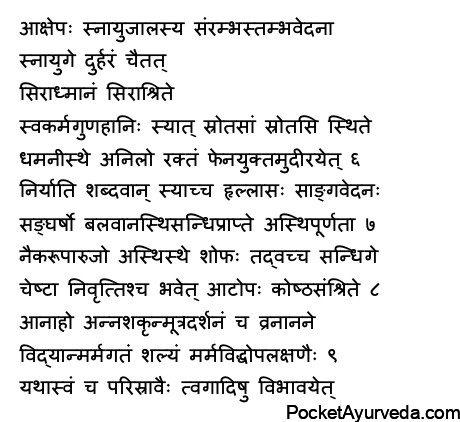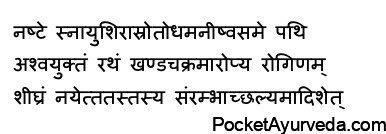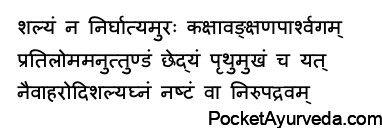This chapter shalya aharana vidhi discusses various methods used in the past to remove foreign bodies. In the past, arrows and other sharp tools were utilized in war. This topic, therefore, held special significance. This chapter is the 28th in Ashtanga Hrudaya Sutrasthana, written by Acharya Vagbhata, the father of Vaidyapathi Simhagupta. The chapter’s title is Shalya Aharana Vidhi.
Shalya is a term used to describe a foreign body. Aharana means extraction, pulling out, etc.
Shalya gati – direction for admission of foreign bodies

Shalya gati – directions for the entry of foreign bodies
Vakra Irregular – curving
Straight, Ruju
Tiryak – horizontal,
Urdhwa upwards and
Adha – downwards are the 5 Shalyagati (directions for movement of foreign bodies)
Shalya Vrana is an ulcer that has an internal foreign body inside

Shalya Vrana – ulcer with a foreign body inside
A swelling, blue discoloration, pain, frequent bleeding that appears like bubbles, dotted with eruptions, and softening muscles are signs of a wound containing a foreign body needing to be identified. 1-2
Tvak gata – Mamsa gata shalya

Tvak gata when the foreign body has been inserted into the skin, there will be the appearance of discoloration and a hard and massive swelling;
Mamsagata(when it’s within the muscle) There will be swelling, the constant progression of swelling with tenderness, suppuration, tenderness, and non-healing of the entry wounds of the foreign body.
When it’s between the two muscles (Peshi), the symptoms will be similar to those that reside within the muscle, except the swelling 3-4
snayu gata shalya/ siragata srotogata asthigata kosthagata marmagata shalya

Snayugata Shalya (tendons) – Convulsions and stiffness, shock, movement loss, and severe pain are some signs when an object of foreign origin is located in the tendons. When a foreign body is lodged in the tendons, and it is difficult to get out;
Siragata Shalya (veins) – there is a vein that is not dilated when it is trapped in the veins; there is an enlargement of the vein
Srotogata Shalya (body channels) – there will be a loss of their functions and characteristics, Dhamanigata shalya (arteries) bleeding, nausea, chest pain, and body ache;
Sandhiagata (joints) Acute shock, pain, and the swelling of various kinds of fluids as well as swelling.
Asthigata (bones) – the symptoms are similar, without movement.
Koshtagata (abdomen) There will be an appearance and enlargement of food-related fecal matter as well as urine around the site of the wound.
Marmagata (vital spots) – the evidence of injury to these spots.
Alongside the usual symptoms, as enumerated in the past, even their discharges – fluids emanating from them, like Lasika (Lymph) in the skin, Rakta (blood) from Arteries and veins, Majja – Marrow bones, and more. It must be watched for. 5-9 1/2

If a foreign body gets trapped in the purest body, cleansed with treatments like Panchakarma, and the foreign body gets within the same vein where the organ is located, chances of healing are high. If the body isn’t clean, it can cause discomfort due to the aggravation of Doshas. 10
Recognizing the location of the foreign body underneath the skin

The exact location of foreign bodies hidden in the skin is identified by
Redness that appears
burning sensation, pain, and tenderness following an application of oil, massage, or fomentation through the melting of Ghee that is solid which is placed on the site,
by the rapid-dried paste made of sandalwood, etc.

The foreign body’s site – hidden within the joint, muscles, and abdominal – is easily identified by removing looseness and thinness of the muscles with Panchakarma or other methods for slimming your body and then looking for areas of redness, pain, etc.
The place of those hidden inside the bones is identified by applying oil to the area or fomentation, tying using a rope or bandage, squeezing, and massaging.
These locations are hidden in joints and can be seen by extension or folding of joints as well as signs like those found in bones.
The hidden places of veins, tendons, and arteries are identified by the appearance of pain in these areas, especially in a horse chariot with broken wheels.

The features of the hidden, vulnerable areas are not mentioned separately, as these spots are made up of other tissues and muscles with the same characteristics previously described. site of the foreign body is determined

Typically, the location of the foreign body can be established through the appearance of disorienting symptoms, abnormal movements, etc., in the course of activity and the presence of discomfort. 17

The form of the external body determines the size of the wound, like round, wide, and circular, with four Angulas and three edges. Etc.18
Shalyaharana- Removal of foreign bodies:

Shalyaharana- removal of foreign bodies
Methods of removal are by moving them in both directions, upwards and downwards;
people entering the body from the top and bottom must be retreated in opposite directions. 19

Those that are entering from the side – horizontally – should be removed by cutting them easily. 19 1/2

Arrow heads are foreign bodies lodged in the chest, the axillae, groins, and axillae. Flanks that can be cut, and contain blades of a board, must be removed.
Shalyas, which should not be removed, to be removed
They can cause death shortly after removal, are hidden or disappear, are in the body’s system, and those that don’t cause complications should not be eliminated. 20-21
Aharana Vidhi- the method of removal and methods to remove

They gripped by the hand must be taken off with the hands.
Other visible ones must be held with instruments like SimhaLion-faced Varmimukha Fish faced Karkata mukha -crab face, etc. 22

They are invisibly visible but can be grasped by instruments, and through the wound, they need to be removed by instruments that have faces similar to the Kankha heron, Bhringaheron, Shrike, Kurara- osprey, Sharari- a kind of heron, and Vayasa Crow. 23

They are encased in the skin and must be eliminated with the aid of Sandamhsaand Yantra (forceps);
The ones that are hollow by using Tala Yantrainstruments made of flat discs,
The ones that are lodged within hollow spaces make use of Naraka Yantratubes, and the rest use other instruments that are convenient. 24

The ones not secured by instruments must be removed by cutting the area with sharp instruments. The wound is then cleaned of the blood, then soaked in Ghee, then instigated, and then wrapped;
Patients are advised to adhere to the prescribed regimen – as described in the verses. 30-42 in the next chapter. 25shalya in veins and tendons

The ones lodged in the veins and tendons, which include nerves, need to be pulled out following the loss of them by using Salaka rod-like instruments. shalya in the heart.

If a foreign object is inside the chest (Hrudaya), the patient must be sprayed with ice (himambu). 26-27

A foreign body, also known as an arrowhead encased within the bones, must be removed by securing the patient in a tight position with the doctor’s help. If this is not feasible, the method described above, then it must be removed by the personnel who are robust. 28

If this is not possible, or even with this method, at least the tail (feather attached to the bow) should be bent and tied tightly onto the strings of the bent bow and the bow that is tied to the bridle piece of the horse is then turned so that it rises its head abruptly. Then with force, the arrow can be removed. 29-30

Additionally, the tree’s branches can be used to use arrows with weak or thin ends; bamboo poles may be used. 31

If an elevation encloses the arrow’s limb, it must be removed following the cutting of the elevation area appropriately. If the arrowhead has created a bulge on the body surface, that needs to be removed by using a Nadiyantra (tubular device) after squeezing or hitting the bulge with the hammer.32

With the hammer, the arrow, which is unclear as to a way to exit, must be made into a suitable passage to be pulled out.
If they have an earlike projection, they are to be removed by cutting out their ears or fixing them into tubular instruments. 33

The arrowheads that do not have earlike projections, have made an open space within the body, and remain in a straight line are easily removed using magnets.

Foreign bodies that have gotten into the large intestine are eliminated through the induction of purgations. 34

Bad air- gas, poison, breast milk, blood, fluids, etc. acting as foreign bodies should be eliminated through sucking using animal horns (Shrunga) and so on. 34 1/2

When the body has traveled into the passageway of the throat, A lotus stalk or sponge-like portion connected with a thread should be inserted through the throat. When the foreign object gets trapped in the stalk, it should be removed gradually. 35

If the body inside the throat is comprised of Lac, the heated iron rod is passed through a tube instrument and then pressed against the foreign body before being taken out. Those that are not composed of Lac must be eliminated by using food that has been that is sprayed with Lac and placed at the tip. 36

Hook-like, thorny bodies – that are found within the throat must be removed through the use of hairballs that are fastened with a thread. This makes the patient vomit out the water which he was made to drink previously. The foreign body stuck to the hairball when vomiting is removed by pulling back the thread quickly.
In the same way, hair and any other foreign body must be eliminated by using hooks. 37

If it is impossible to remove the foreign bodies stuck in the mouth or the nose through orifices in the respective areas, they should be moved backward, allowing them to pass through the larger tract. 38

If an ounce of food gets stuck within the throat area, the food must be removed using thread, flax cloth hair, silk, or even water. 39

The person who has taken in the water up to his stomach through drowning ought to be kept with his legs and head up and shaken thoroughly, then laid on the ground with his face bent downwards and forced to vomit out all the water. He should then be buried in an ash heap. 40

If the ear canals are filled with water, they must be removed by inserting the fingers and oil removers placed in the ear, or the ears should be positioned downwards, and the sides are striking the head. The water may be taken out by the use of a tubular instrument 41

If an insect has penetrated the ear, the ear must be full of warm salt water or Greek (Sukta). Dehydration measures must be implemented when the insect has died, or the ears must be covered with water. 42

Foreign bodies made of Lac and other elements that stay long in the body are dissolved due to the body’s heat. 43

Foreign bodies comprise bamboo, Mud wood, horn bone tooth, and hair of man or animal. Stones are not broken down through body heat.
Horns are made up of Bamboo, Iron, and wood from palm trees or left for prolonged periods within the body, tend to become distorted, are not dissolved, and cause putrefaction within the tissues and the blood. 44- 44 1/2

When the body has been hidden within fleshy organs, it is essential to purify within these areas by squeezing fomentation, thinning, and smoothing treatments, using hot, strong poultices that warm beverages and food cutting and other methods that involve sharp instrumentation or trampling using feet. And then, the foreign body is eliminated by excision, cutting, or probing. 45-46

Be aware of the various and distinctive characteristics of foreign bodies, their places of rest, and tools of removal; the savvy doctor should be able to recognize the foreign bodies and remove them using proper methods. 47- 47 1/2
This chapter is titled Salyaharana Vihi, twenty-eighth of Sutrasthana of Astanga Hrurdaya.


